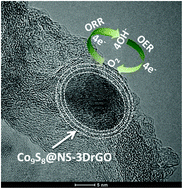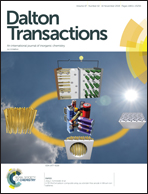N,S-Atom-coordinated Co9S8 trinary dopants within a porous graphene framework as efficient catalysts for oxygen reduction/evolution reactions†
Abstract
The intrinsic instability and difficulty in controlling the uniform size distributions of cobalt sulfides greatly restrict their application for the oxygen reduction reaction (ORR) and oxygen evolution reaction (OER) as a bifunctional electrocatalyst in regenerative fuel cells and rechargeable metal–air batteries. Herein, we synthesize a stable electrocatalyst of N,S-atom-coordinated Co9S8 trinary dopants within a porous graphene framework (Co9S8@NS-3DrGO), in which Co9S8 nanoparticles show uniform sizes and distributions. The stable Co9S8-based composites are fabricated by a facile soft template-assisted strategy, and the attraction of this method is that the intermediate of melamine formaldehyde resin (MFR) plays trifunctional roles, including (i) it acts as the templated bonding material to crosslink GO sheets together, (ii) it facilitates the formation of a core–shell architecture, and (iii) it acts as the N source for doping. Catalyst composition and performance are largely dependent on the pyrolysis temperature. Extensive investigation elucidates that the mechanism of electrocatalytic activity is attributed to: (i) the unique core–shell structure of the composites, as well as uniform particle sizes and distributions of Co9S8, (ii) the active nitrogen (pyridinic N and graphitic N) contents, and (iii) the large surface area and porous architecture. The composite pyrolyzed at 850 °C exhibits the best electrocatalytic performance, which shows a positive ORR half-wave potential (0.826 V), a small OER overpotential (317 mV) at 10 mA cm−2, and high stability, comparable to the commercial noble catalysts Pt/C and RuO2 in alkaline media. Furthermore, when applied in zinc–air batteries, it also displays a comparable performance to a Pt/C + RuO2 mixture catalyst. This work provides an approach to stabilize cobalt sulfides and control their particle sizes and distributions by ingeniously employing the soft template of MFR and pyrolyzing them at various temperatures.



 Please wait while we load your content...
Please wait while we load your content...